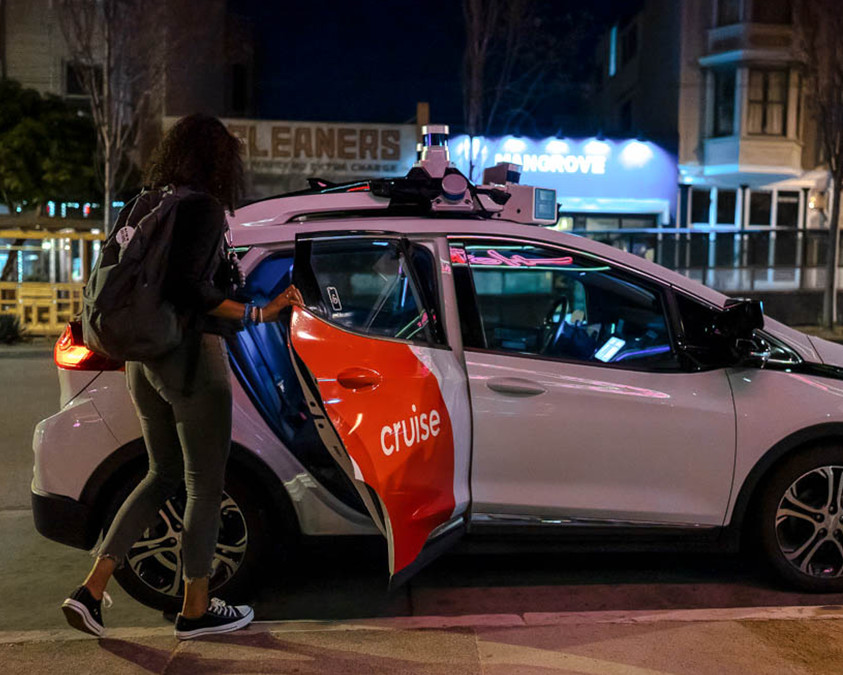Things to watch out for in the nearer-than-you-think future, with Austin first in line.
When transit systems experience delays, the reason usually isn’t very interesting: congested streets, medical emergencies, mechanical problems. But the cause of a recent holdup on San Francisco’s MUNI system at least had the virtue of being novel.
On Sept. 30 at around 11 p.m., an N Line streetcar ground to a halt at the intersection of Carl Street and Cole Street because an autonomous vehicle from Cruise, a subsidiary of General Motors, had halted on the streetcar tracks and wouldn’t budge. According to the city’s transportation department, the 140 passengers riding the N line that evening were stuck in place for seven minutes before a Cruise employee arrived and moved the driverless conveyance. (Cruise did not respond to questions about what happened that night.)
This incident, which was not reported in the media at the time, is one of many in which autonomous vehicles roaming San Francisco’s streets have disrupted the city’s transportation network. In April, a Cruise vehicle blocked a travel lane needed by a siren-blaring fire engine, delaying its arrival at a three-alarm fire. Last fall, dozens of self-driving cars from Google’s Waymo subsidiary drove daily into a quiet cul-de-sac before turning around, much to the frustration of nearby residents.
Because of California’s insufficient and outdated AV reporting requirements, many incidents like these have escaped both public attention and regulatory consequences. Facing minimal scrutiny, AV companies have little incentive to avoid mucking up the public right of way—or even keep city officials informed about what’s happening on their streets.
With Silicon Valley a few miles away, San Francisco has become the top urban location for AV testing and deployment. With California officials granting their first AV deployment permits allowing passenger service this year, the city now offers a preview of what’s to come in other places where self-driving companies are now fanning out, with expansions announced for Los Angeles, Las Vegas, Phoenix, and Austin.
Based on San Francisco’s experience, residents and officials in those cities should brace for strange, disruptive, and dangerous happenings on their streets. And they should demand that state officials offer the protection that California is failing to provide.
[…]
The National Association of City Transportation Officials, representing municipal transportation departments across North America, submitted its own letter to the NHTSA that flatly opposed GM’s request that the Cruise Origin receive an exemption from vehicle safety rules. (NHTSA has not yet made a decision.) Kate Fillin-Yeh, NACTO’s director of strategy, said urban transportation leaders nationwide are watching events unfold in San Francisco with growing concern. “I know that AV companies can make more money in cities because there is a density of people there,” she said, “but they’re unhelpful to the many people who rely on transit or walk.”
Indeed, beyond the wow factor of stepping inside a self-driving car, it’s unclear how exactly the introduction of robotaxis improves an urban transportation network. But the risks—including disruptions on public roadways, increased congestion, and reduced transit use—are very real.
Fillin-Yeh said her top request for federal and state policymakers is that they empower local leaders to monitor and manage AVs using their streets. “Cities need to be a part of these conversations about permitting and regulating AVs,” she said. “That isn’t always happening.”
In their letter to NHTSA, San Francisco officials proposed several ways to improve AV oversight. They suggested that NHTSA treat “travel lane failures that block roadways” as a key measure of AV readiness, adding that NHTSA should also quantify and publicize AV companies’ response times to vehicle emergencies.
Riggs, the University of San Francisco professor, agreed on the need to evaluate AV companies’ emergency response times, adding that governments must be especially careful to protect so-called vulnerable road users. “We should be collecting autonomous vehicles’ near-misses with pedestrians and cyclists,” he said.
Driverless taxis have been a thing since 2016, with the first domestic service beginning in Phoenix in 2018. As the story notes, GM subsidiary Cruise has opened a waitlist for its service launch in Austin, supposedly by the end of this year, among other cities. While this story is mostly about the failure of the state of California to provide oversight of these things, the point is that other states will soon have the same opportunity to fail to provide oversight. The Lege has largely rolled out the red carpet for companies that want to test autonomous vehicles – you’ve seen my regular series of posts about autonomous trucks and various driverless delivery services. Given the Republican urge to screw cities, along with the law passed a few years ago curtailing cities’ ability to regulate rideshare services, I think we can predict how this will go. Barring a Republican legislator getting mowed down (or stuck behind) one of these things, it’ll be laissez-faire as usual. Get ready for it. In a bit of good timing, this Sunday’s episode of What Next TBD has more.

